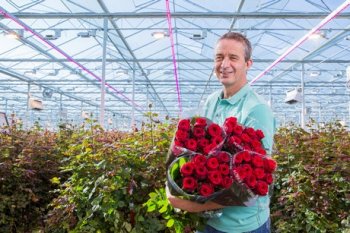
Shortly after piloting hybrid LED and high-pressure sodium (HPS) grow light installations, both growers have decided to expand their LED investment following yields increasing by up to 50 percent.
Scheers Rose Nursery in Kontich, Belgium, grows a variety of large-flower roses in 3.5 hectares of greenhouses. It trialed several varieties of roses in a hybrid system with 70% Philips GreenPower LED toplighting modules and 30% HPS modules over 1.5 hectares. Its aim was to increase light levels without increasing energy usage.
Owner, Wim Scheers said, “Our yields have increased by 30%-50% in the hybrid set-up. We can now light our plants for extended periods of time without raising the crop temperature while retaining increased amounts of CO2. This helps boost the growth of our crops. Furthermore, we have seen a clear improvement in the quality of our roses with longer stems, bigger flowers and higher yields. After just half a season, we saw that Philips horticultural LED lighting is the best option for growing roses, so we’re expanding our LED lighting installation by 60% from 1.5 hectares to 2.5 hectares.”
Porta Nova, one of the world’s largest growers of Red Naomi roses, decided to create an additional 1.1 hectare greenhouse with a 50% HPS and 50% LED toplighting installation after successful trials.
“Philips horticultural LED lighting will provide us with more flexibility and more light in the spring, summer and autumn seasons” said Leon Dukker, general manager at Porta Nova. “Further, we expect to grow bigger flowers and achieve more uniform quality across the crop in the hybrid set-up. We can slow the flowering and get a better crop temperature thanks to better climate control while securing substantial energy savings. Our goal with the hybrid LED installation is to use precise climate control to further improve the consistency, flowering and shelf life of our crops to produce an even better product for our customers.”
In 2015, Porta Nova conducted a cut rose trial over 1,300 square meters, comparing a hybrid system comprising HPS and Philips GreenPower LED toplighting to an HPS-only installation with the aim of increasing light levels without increasing heat. Increasing light levels with HPS lighting causes high temperatures in the greenhouse outside of the winter months.
Full LED rose cultivation predicted within five years
Wim Steeghs, horticultural lighting key account manager and rose specialist at Philips Lighting, said, “LED technology is now mature, energy efficient and precise enough to be applied in rose cultivation. Growers are starting with hybrid installations, and we think that in five years most rose growers will have a hybrid or full LED installation because of the benefits it offers in improving crops and lowering operational expenses.”
Dutch and Belgian rose growers expand use of Philips horticultural LED lighting after 50 percent surge in crop yields.
For more information, visit: www.philips.com/horti



 Classifieds
Classifieds

